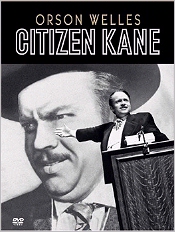 |
Citizen KaneRKO |
|---|
 |
Citizen KaneRKO |
|---|
|
Orson Welles - Charles Foster Kane Joseph Cotten - Jedediah Leland Dorothy Comingore - Susan Alexander Kane Agnes Moorehead - Mary Kane Ruth Warrick - Emily Monroe Norton Kane Everett Sloane - Mr. Bernstein |
Orson Welles - Director Orson Welles - Producer Orson Welles - Screenwriter Herman J. Mankiewicz - Screenwriter Gregg Toland - Cinematographer Bernard Herrmann - Film Score |
Orson Welles' connection to film noir, like his connection to virtually everything else in the history of American film, is that of bold innovator rather than intelligent follower. He is the only American director whose contribution to noir equals that of the German expatriates. Among its many other claims to landmark status, Citizen Kane also exerted an enormous influence on both the visual and narrative patterns which were to coalesce into the recognizable noir style.
Released in 1941, Citizen Kane appears at the head of the noir cycle, in the same year as The Maltese Falcon. Perhaps it, rather than John Huston's thriller, should be considered the primal American film noir. Kane, of course, is not a crime film and thus stands apart from noir in this important respect; but in the way it tells its story, as well as in its visual idion, the film contains many of the crucial elements that were to define noir technique. With its journalist assuming the role of the investigating detective, and its quest for the meaning of Rosebud substituting for the whodunit motif of the traditional murder thriller, Kane is constructed like a mystery.
The film's splintered structure--the divergent points of view of people whom the journalist interviews, the interweaving of past and present, the series of flashbacks--anticipates the narrative labyrinths of many of the richest films noirs. And the film's celebrated compositions, in which the frame is divided into fragments of light and shadow, also clearly point toward noir. Kane was the first major American film steeped in the shadowy universe of the German Expressionists. Welles' delight in exaggerated angles--the famous low angle shots which distort the characters' appearance--also became a standard part of noir syntax.
Although Kane is a titanic figure, a man of destiny, he is often placed within the frame in such a way as to suggest confinement and limitation. Low angle shots, which magnify Kane's physical stature (even in his twenties, Welles was of Falstaffian proportions), also contain ceilings which seem to weigh down on the character and to diminish him. Cutting him down to size, the low ceilings provide an ironic counterpoint to Kane's dominant personality. Welles' careful placement of all his actors within the frame restricts their freedom; they seem to move only at the director's bidding, and the orchestration, together with the pervasive images of visual entrapment, gives the film the claustrophobic quality of the noir thrillers that follow.
Welles is clearly indebted to German Expressionism, but he avoids its extreme stylization, eliminating abstract settings, exaggerated acting, and nightmarish distensions of time and space. More stylized than the average American film--than any major studio American film up to this time--Kane is not a dream film, altogether remote from a recognizable world. Welles is careful to balance Expressionist elements with techniques such as depth of field, the long take, and overlapping dialogue which enforce a sense of reality.
When Welles later made films that were clearly in the noir vein, he was returning to a style his own seminal work had helped to forge. Thus, The Lady from Shanghai in 1947 and Touch of Evil eleven years later are unmistakably by the same man who had directed Citizen Kane. These two full-fledged nor dramas fall short of Kane, but Welles treats them in the same bravura style. In fact, Welles used a noir style for nearly everything he worked on. Even his versions of The Trial (1963), and of Macbeth (1948) and Othello (1952), have the feel of film noir in their calculated imagery of nightmare and entrapment, their delirious angles, their bizarre settings and circumambient shadows.
Citizen Kane is consistently regarded as one of the greatest films ever made. There is little doubt that it deserves that accolade. The individuals inolved in all aspects of the picture were people of exceptional creative ability. The film's composer, Bernard Herrmann, is regarded as one of the greatest composers of music for films, and was nominated for an Academy Award for his score to Citizen Kane. Welles, the film's director and star, though inconsistent in his career, is still regarded as one of the great geniuses of film. The pre-eminent American director of noir, Orson Welles is the most flamboyant of noir stylists.
--FOSTER HIRSCH, from Film Noir
The Dark Side of the Screen.
A selection of Citizen Kane related films.
|
Find Citizen Kane on eBay.com
A selection of Citizen Kane in books.
|
|
home: The Film Noir 'net |
back: forward: FILM LIST ALMOST NOIR |
|
Any comments, additions or suggestions
should be addressed to: The Film Noir 'net / Eric B. Olsen / ericbolsen@juno.com |
Other Web Sites:
History of Horror Hard Bop Homepage The War Film Web Author Eric B. Olsen |